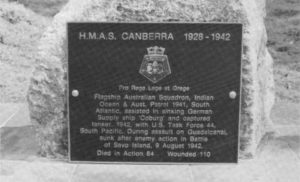- Author
- Smith, Peter
- Subjects
- History - WW2, History - WW1, Biographies and personal histories
- Tags
-
- RAN Ships
- HMAS Oxley I, HMAS J7, HMAS J1, HMAS Australia II, HMAS Tingira, HMAS Kanimbla I, HMAS Canberra I, HMAS Brisbane I, HMAS Platypus
- Publication
- June 1994 edition of the Naval Historical Review (all rights reserved)
At the battle of Savo Island on 9 August, 1942 CANBERRA was mortally damaged in a surprise night sortie by Japanese Admiral Mikawa’s cruiser squadron. The Australian cruiser was hit by torpedoes and 24 large calibre shells at point blank range. Eighty-two of her crew were killed and 109 wounded.
Captain Getting was severely wounded and when found by Surgeon Commander Downward, Frank refused medical attention and ordered him to look after the others. With assistance from the Coxswain he was propped up on a stool where he directed operations as best he could. Later, despite his protests, Captain Getting was evacuated along with the other wounded officers and ratings and carried aboard the American destroyer USS PATTERSON.
Later that day he was transferred to the attack transport USS BARNETT which proceeded to steam for New Caledonia. Captain Getting died while on passage to the island and was buried at sea.
Before the Navy released a statement to the public on the loss of HMAS CANBERRA, Mrs. Getting received official word that her husband had been killed. She was attending a tea party with wives of other men on the cruiser and had to keep her secret.
After the people of Australia had been informed of the loss of the CANBERRA by the Prime Minister, Mr. Curtin, the journalist J.H. Adams, the author of “Ships in Battledress”, interviewed Mrs. Getting at her Macleay Street flat in Potts Point, Sydney. He later wrote of the following conversation in which Mr. Getting stated: “I am proud of Frank. He loved the sea and he was willing if needs be, to give his all for his country. He would not have wished to go in any other way. It is up to us to see now that the men we love have not given their lives in vain. I thank God that so many of those young lives on the CANBERRA have been saved. I thank God that my husband, although he has gone, was instrumental in giving back to their wives and others so many loved ones“.

Photo kind favour John Jeppeson (1993)
At war’s end and the return of servicemen to Australia, the Submarine Old Comrades Association held a memorial church service in memory of their President, Captain Frank E. Getting and four other members who gave their lives to God, King and Country.
Admiral, Sir Ragnar Colvin, formerly First Naval Member to the Australian Naval Board, wrote in the London Times of Captains Burnett, Waller and Getting:
“No finer sailors ever trod the deck. To one who has known them and worked with them there was something out of the ordinary about these sailors of the RAN. Coming from the Australian Naval College they worked and trained for years on their own and with the Royal Navy but they were never mere copyists. They assimilated the knowledge and traditions of the older service, but blended with it something peculiar to themselves and the result was unmistakable and unmistakably good“.
BIBLIOGRAPHY:
BOOKS
ADAMS, J.H.-Ships in Battledress, The Currawong Publishing Co., Sydney.
GILL, G. HERMON-Royal Australian Navy, 1939-42, Australian War Memorial, The Griffin Press, Adelaide 1968.
GILL, G. HERMON – Royal Australian Navy, 1942-45, Australian War Memorial, The Griffin Press, Adelaide 1968.
Jane’s Fighting Ships of World War I, Military Press, New York 61990.
JOSE, A.W.-The Royal Australian Navy, 1914-1918, University of Queensland Press in association with the Australian War Memorial. Queensland 1987.
ODGERS, GEORGE-The Royal Australian Navy, an Illustrated History, Child & Henry Publishing Pty. Ltd., Sydney 1982.
THOMAS, DAVID A.-.-1 Companion to the Royal Navy, Harrap Limited, 19-23 Ludgate Hill, London EC4M 7PD. 1988.
DOCUMENTS
Captain Letting’s service records. Naval Archives, Canberra.




